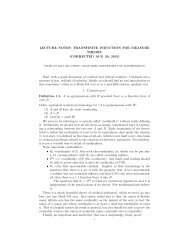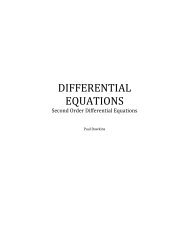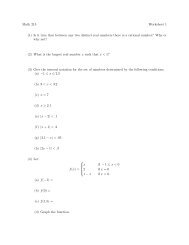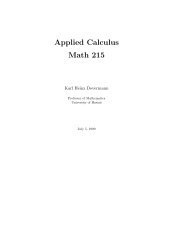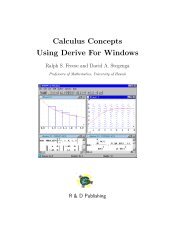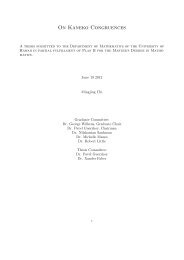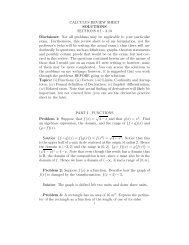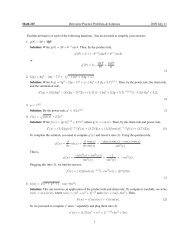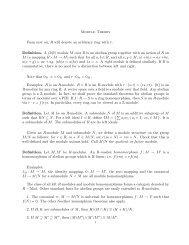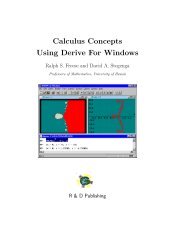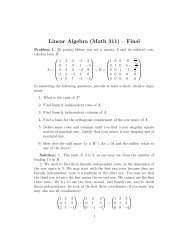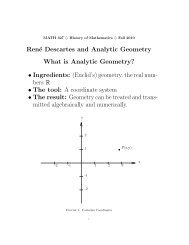Problems and Solutions in - Mathematics - University of Hawaii
Problems and Solutions in - Mathematics - University of Hawaii
Problems and Solutions in - Mathematics - University of Hawaii
Create successful ePaper yourself
Turn your PDF publications into a flip-book with our unique Google optimized e-Paper software.
1.7 2007 November 16 1 REAL ANALYSIS<br />
1.7 2007 November 16<br />
Notation: R is the set <strong>of</strong> real numbers <strong>and</strong> R n is n-dimensional Euclidean space. Denote by m Lebesgue measure on<br />
R <strong>and</strong> mn n-dimensional Lebesgue measure. Be sure to give a complete statement <strong>of</strong> any theorems from analysis that<br />
you use <strong>in</strong> your pro<strong>of</strong>s below.<br />
1. Let µ be a positive measure on a measure space X. Assume that E1, E2, . . . are measurable subsets <strong>of</strong> X with the<br />
property that for n = m, µ(En ∩ Em) = 0. Let E be the union <strong>of</strong> these sets. Prove that<br />
µ(E) =<br />
∞<br />
µ(En)<br />
Solution: Def<strong>in</strong>e F1 = E1, F2 = E2 \ E1, F3 = E3 \ (E1 ∪ E2), . . . , <strong>and</strong>, <strong>in</strong> general,<br />
n=1<br />
n−1 <br />
Fn = En \ Ei (n = 2, 3, . . . ).<br />
i=1<br />
If M is the σ-algebra <strong>of</strong> µ-measurable subsets <strong>of</strong> X, then Fn ∈ M for each n ∈ N, s<strong>in</strong>ce M is a σ-algebra. Also,<br />
Fi ∩ Fj = ∅ for i = j, <strong>and</strong> F1 ∪ F2 ∪ · · · ∪ Fn = E1 ∪ E2 ∪ · · · ∪ En for all n ∈ N. Thus,<br />
<strong>and</strong>, by σ-additivity <strong>of</strong> µ,<br />
∞<br />
n=1<br />
Fn =<br />
n=1<br />
∞<br />
En E,<br />
n=1<br />
∞<br />
∞<br />
µ(E) = µ( Fn) = µ(Fn).<br />
Therefore, if we can show µ(En) = µ(Fn) holds for all n ∈ N, the pro<strong>of</strong> will be complete.<br />
Now, for each n = 2, 3, . . . ,<br />
<strong>and</strong><br />
n=1<br />
n−1 <br />
Fn = En ∩ ( Ei) c<br />
i=1<br />
n−1 <br />
µ(En) = µ(En ∩ ( Ei) c n−1 <br />
) + µ(En ∩ ( Ei)). (24)<br />
Equation (24) holds because n−1<br />
i=1 Ei is a measurable set for each n = 2, 3, . . . . F<strong>in</strong>ally, note that<br />
which implies<br />
i=1<br />
n−1 <br />
En ∩ ( Ei) =<br />
i=1<br />
n−1 <br />
µ(En ∩ ( Ei)) ≤<br />
i=1<br />
<br />
(En ∩ Ei),<br />
n−1<br />
i=1<br />
i=1<br />
n−1 <br />
µ(En ∩ Ei),<br />
by σ-subadditivity. By assumption, each term <strong>in</strong> the last sum is zero, <strong>and</strong> therefore, by (23) <strong>and</strong> (24),<br />
n−1 <br />
µ(En) = µ(En ∩ ( Ei) c ) = µ(Fn) holds for each n = 2, 3, . . . .<br />
i=1<br />
For n = 1, we have F1 = E1, by def<strong>in</strong>ition. This completes the pro<strong>of</strong>. ⊓⊔<br />
32<br />
i=1<br />
(23)




